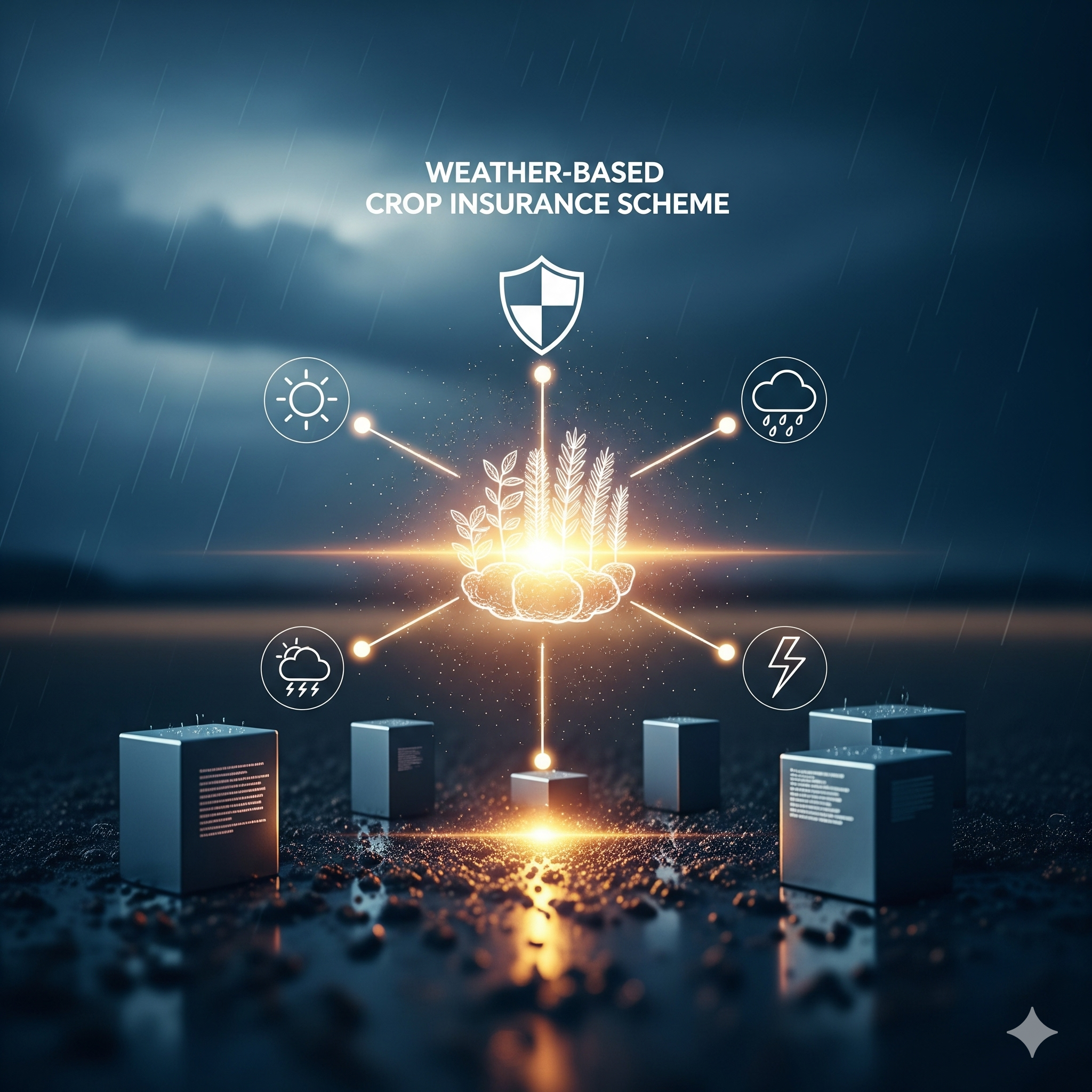Introduction
Agriculture in India is highly dependent on weather conditions. Variability in rainfall, temperature extremes, droughts, floods, and unseasonal events can significantly affect crop yields. Traditional crop insurance schemes often struggled to provide timely relief to farmers due to delayed loss assessments and area-based compensation models.
To address these challenges, the Weather-Based Crop Insurance Scheme (WBCIS) was introduced as a pilot initiative by the Government of India. This scheme focuses on compensating farmers based on weather indices, such as rainfall, temperature, and wind speed, rather than direct assessment of crop loss.
By linking insurance payouts to objective weather parameters, WBCIS reduces adverse selection and moral hazard problems, ensures faster claim settlement, and encourages farmers to adopt climate-resilient agricultural practices.
History and Evolution of WBCIS
Background
- Traditional schemes like the National Agricultural Insurance Scheme (NAIS) and Modified NAIS faced challenges such as:
- Delayed claim settlement due to post-harvest loss assessment.
- Administrative burden of area-based crop cutting experiments.
- Inefficiency in addressing localized weather events affecting crop yield.
Launch of WBCIS
- 2003–04: The Government of India piloted the Weather-Based Crop Insurance Scheme in select districts.
- The Agriculture Insurance Company of India (AIC), in collaboration with state governments, implemented the scheme.
- Initially limited to rainfed crops like paddy, wheat, maize, and pulses in districts prone to climatic variability.
Key Milestones
- 2007–08: WBCIS expanded under the National Agricultural Insurance Scheme (NAIS) umbrella to more states and crops.
- 2010 onwards: Integration with other risk mitigation programs and modernization of weather monitoring systems.
- 2016 onwards: Alignment with Pradhan Mantri Fasal Bima Yojana (PMFBY) to enhance coverage and streamline operations.
Objectives of WBCIS
The main objectives of the Pilot Weather-Based Crop Insurance Scheme are:
- Timely Compensation – Provide payouts quickly after adverse weather events.
- Financial Security for Farmers – Protect farmers against losses caused by extreme weather conditions.
- Reduce Credit Risk – Enable banks to continue lending to farmers without fear of default due to weather-related crop failure.
- Encourage Technology Adoption – Promote the use of modern weather monitoring and data-driven farming practices.
- Enhance Climate Resilience – Encourage farmers to adapt to changing climatic conditions through informed decision-making.
Key Features of WBCIS
- Weather Index-Based Payouts
- Insurance compensation is linked to pre-determined weather parameters, such as:
- Rainfall deficit or excess
- Maximum/minimum temperature
- Wind speed or cyclone intensity
- Payout is triggered automatically once weather parameters breach a threshold.
- Insurance compensation is linked to pre-determined weather parameters, such as:
- Area Approach and Village-Level Index
- Weather stations are installed in specific villages or clusters of villages.
- The indemnity is calculated at the village or block level rather than assessing individual farm loss.
- Weather stations are installed in specific villages or clusters of villages.
- Crop and Farmer Coverage
- Initially focused on rainfed crops like cereals, pulses, and oilseeds.
- Later extended to horticultural crops and commercial crops in pilot districts.
- Both small and marginal farmers, as well as large farmers, can participate.
- Premium Structure
- Farmers pay a nominal premium, often subsidized by the government.
- Premium is usually lower than traditional crop insurance due to objective, automated loss assessment.
- Timely Settlement
- As payouts are linked to weather indices, claims can be processed within weeks of the event, reducing financial distress.
- As payouts are linked to weather indices, claims can be processed within weeks of the event, reducing financial distress.
- Risk Management Integration
- Farmers receive alerts and advisories from local agriculture departments and weather stations.
- Encourages preventive and adaptive measures like irrigation scheduling, crop selection, and pest control.
How the Pilot WBCIS Works
- Identification of Risk-Prone Areas
- Based on historical weather patterns, drought-prone or flood-prone districts are selected.
- Based on historical weather patterns, drought-prone or flood-prone districts are selected.
- Installation of Weather Stations
- Automatic weather stations (AWS) record rainfall, temperature, wind, and humidity.
- Data is transmitted to a central monitoring system.
- Farmer Enrollment
- Farmers register their crops and fields with the local insurance provider or agriculture department.
- Farmers register their crops and fields with the local insurance provider or agriculture department.
- Defining Thresholds
- Thresholds for weather parameters (e.g., rainfall less than 50 mm during a critical growth phase) are predetermined.
- Thresholds for weather parameters (e.g., rainfall less than 50 mm during a critical growth phase) are predetermined.
- Monitoring and Triggering of Payouts
- If the weather parameter breaches the threshold, insurance compensation is automatically triggered.
- If the weather parameter breaches the threshold, insurance compensation is automatically triggered.
- Disbursal of Compensation
- Payments are made directly to farmers’ bank accounts, ensuring prompt relief.
Benefits of WBCIS
For Farmers
- Timely compensation reduces economic stress.
- Encourages participation in formal insurance schemes.
- Promotes adoption of climate-resilient practices.
- Provides an objective assessment of losses, reducing disputes.
For Banks and Financial Institutions
- Reduces credit risk associated with lending to farmers.
- Encourages continued flow of agricultural credit.
For Government and Economy
- Supports rural income stability.
- Encourages data-driven agricultural policy making.
- Reduces dependency on ad hoc disaster relief funds.
Challenges of WBCIS
- Weather Data Accuracy
- Quality and frequency of weather data are crucial.
- Insufficient or poorly maintained weather stations may lead to incorrect payouts.
- Basis Risk
- Sometimes individual farmers may suffer losses even if weather indices at village level are normal.
- This can lead to dissatisfaction among affected farmers.
- Sometimes individual farmers may suffer losses even if weather indices at village level are normal.
- Limited Awareness
- Many farmers, especially in remote areas, are unaware of WBCIS.
- Many farmers, especially in remote areas, are unaware of WBCIS.
- Infrastructure and Cost
- Setting up weather stations and maintaining them involves high costs.
- Setting up weather stations and maintaining them involves high costs.
- Integration with Other Schemes
- Aligning WBCIS with crop loans, PMFBY, and other insurance schemes can be administratively challenging.
Comparison with Traditional Crop Insurance (NAIS/PMFBY)
| Feature | NAIS/PMFBY | WBCIS (Pilot) |
|---|---|---|
| Basis of Claim | Actual crop loss assessed | Weather parameter indices |
| Assessment | Area/Block-based crop cutting experiments | Automated weather data from stations |
| Speed of Compensation | Slow (weeks to months) | Faster (within weeks) |
| Moral Hazard | High | Reduced due to objective triggers |
| Coverage | All major crops | Initially rainfed, extended to horticulture/commercial crops |
| Technology Dependence | Low | High (weather stations, sensors) |
Future of WBCIS
- Technology Integration
- Use of satellite imagery, AI, and IoT sensors to enhance accuracy.
- Use of satellite imagery, AI, and IoT sensors to enhance accuracy.
- Expansion Across States
- Initially pilot projects; plans to scale WBCIS nationally for all high-risk zones.
- Initially pilot projects; plans to scale WBCIS nationally for all high-risk zones.
- Climate-Resilient Agriculture
- WBCIS encourages farmers to adopt drought-tolerant varieties and water-saving techniques.
- WBCIS encourages farmers to adopt drought-tolerant varieties and water-saving techniques.
- Linkage with Digital Platforms
- Integration with e-NAM and PMFBY to ensure seamless risk management and financial inclusion.
- Integration with e-NAM and PMFBY to ensure seamless risk management and financial inclusion.
- Public-Private Collaboration
- Insurance companies and tech providers collaborating to provide innovative weather-index products.
Role in Improving Farmers’ Economy
- Reduces Dependence on Informal Credit: Farmers can avoid high-interest loans from moneylenders during crop failure.
- Encourages Timely Planting and Modern Practices: With risk mitigation in place, farmers invest in better seeds, fertilizers, and irrigation.
- Stabilizes Rural Income: Automatic compensation ensures farmers have liquidity for household and farm expenses.
- Supports National Agriculture Goals: Contributes to doubling farmers’ income and promoting sustainable agriculture.
Conclusion
The Pilot Weather-Based Crop Insurance Scheme (WBCIS) represents a significant innovation in agricultural risk management in India. By linking compensation directly to weather indices, it reduces delays, administrative burden, and moral hazard, while encouraging farmers to adopt climate-smart practices.
Although challenges like basis risk, infrastructure requirements, and awareness remain, WBCIS lays the foundation for a resilient, technology-driven agricultural insurance ecosystem. Its integration with broader initiatives like PMFBY, digital platforms, and climate-resilient agriculture programs ensures that farmers across India can secure their livelihoods against increasingly unpredictable weather patterns.
With continued investment in technology, awareness campaigns, and integration with financial and market systems, WBCIS has the potential to transform agricultural insurance in India and provide a sustainable safety net for millions of farmers.




